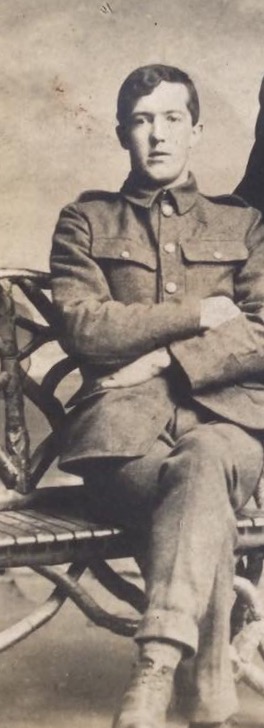Cpl
Bleddyn Rees
Information about birth
|
Year of birth: 1891 |
|
Place of birth: Pantperthog, Merionethshire, Wales, United Kingdom |
General information
|
Profession: Labourer |
Army information
|
Country: Wales, United Kingdom |
|
Force: British Expeditionary Force |
|
Rank: Corporal |
|
Service number: 14238 |
|
Enlistment date: 27/12/1914 |
|
Enlistment place: Tonypandy, Glamorgan, Wales, United Kingdom |
|
Units: — Devonshire Regiment, 9th Bn. (Last known unit) |
Information about death
|
Date of death: 24/10/1917 |
|
Place of death: Veldhoek, Geluveld, Belgium |
|
Cause of death: Killed in action (K.I.A.) |
|
Age: 26 |
Cemetery
|
Tyne Cot Cemetery Plot: LX Row: D Grave: 1 |
Distinctions and medals 3
|
1914-15 Star Medal — 12/11/1919 |
|
British War Medal Medal |
|
Victory Medal Medal |
Points of interest 3
| #1 | Place of birth | ||
| #2 | Enlistment place | ||
| #3 | Place of death (approximate) |
My story
Corporal Bleddyn Rees served in the Devonshire Regiment 9th Battalion, which was part of the 20th Brigade of the 7th Division.
On the 26th of October 1917 the 7th Division participated in the Second Battle of Passchendaele, the final phase of the Third Battle of Ypres. The Division had to attack astride the Menin Road towards the village of Geluveld. This was necessary to prevent the Germans thinning that sector and sending reinforcements further north towards Passchendaele.
Two days before the start of the Second Battle of Passchendaele, the 9th Battalion took up positions in the frontline, near the hamlet of Veldhoek, just northwest of the village of Geluveld. They relieved two Battalions of the 14th Division in the line. The 20th Brigade, among which the 9th Battalion, moved up towards Geluveld in the evening of October 24 1917 to relieve two Battalions, as mentioned above. The relief was completed by 9.30 p.m. During the relief the 2nd Company of the 9th Battalion suffered 27 casualties due to shellfire.
Corporal Bleddyn Rees was killed in action on October 24 1917. He was initially buried near Veldhoek, not far from the Menin Road. It is plausible to assume that Rees was killed due to German shellfire while the Devonshire Regiment 9th Battalion moved in the frontline opposite Geluveld. His remains were exhumed after the war and interred in Tyne Cot Cemetery.
On the 26th of October 1917 the 7th Division participated in the Second Battle of Passchendaele, the final phase of the Third Battle of Ypres. The Division had to attack astride the Menin Road towards the village of Geluveld. This was necessary to prevent the Germans thinning that sector and sending reinforcements further north towards Passchendaele.
Two days before the start of the Second Battle of Passchendaele, the 9th Battalion took up positions in the frontline, near the hamlet of Veldhoek, just northwest of the village of Geluveld. They relieved two Battalions of the 14th Division in the line. The 20th Brigade, among which the 9th Battalion, moved up towards Geluveld in the evening of October 24 1917 to relieve two Battalions, as mentioned above. The relief was completed by 9.30 p.m. During the relief the 2nd Company of the 9th Battalion suffered 27 casualties due to shellfire.
Corporal Bleddyn Rees was killed in action on October 24 1917. He was initially buried near Veldhoek, not far from the Menin Road. It is plausible to assume that Rees was killed due to German shellfire while the Devonshire Regiment 9th Battalion moved in the frontline opposite Geluveld. His remains were exhumed after the war and interred in Tyne Cot Cemetery.
Sources 2
|
Atkinson C.T. ,The Devonshire Regiment, 1914-1918, (London, Eland Brothers, Kent & Co. Ltd., 1926, Vol. 1), pg. 274-294. Sources used |
|
McCarthy C., The Third Ypres Passchendaele. The Day-by-Day Account, (London, Arms & Armour Press, 1995), pg. 123-125. Sources used |
More information 3
|
Commonwealth War Graves Commission Database https://www.cwgc.org/find-records/find-war-dead/casualty-details/464390 |
|
Namenlijst (In Flanders Fields Museum) https://namenlijst.org/publicsearch/#/person/_id=3711e781-cd9b-4992-af11-676b21e8409a |
|
Lives of the First World War (Imperial War Museum) https://livesofthefirstworldwar.iwm.org.uk/lifestory/3686404 |
